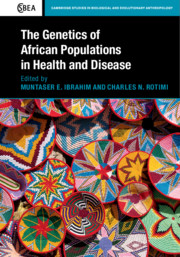Book contents
- The Genetics of African Populations in Health and Disease
- Cambridge Studies in Biological and Evolutionary Anthropology
- The Genetics of African Populations in Health and Disease
- Copyright page
- Contents
- Contributors
- 1 Reflections on Conceptualizing Africa for Biological Studies with a Historical Component
- 2 History and Genetics in Africa
- 3 Disease, Selection, and Evolution in the African Landscape
- 4 Genetic Susceptibility to Visceral Leishmaniasis
- 5 Genetics of Infection in Sub-Saharan Africa
- 6 Pharmacogenomics and Infectious Diseases in Africa
- 7 A Glimpse into Pharmacogenomics in Africa
- 8 Genomics of Cardiometabolic Disorders in Sub-Saharan Africa
- 9 Breast Cancer in African Populations
- 10 Sociobiological Transition and Cancer
- 11 The Genetic Epidemiology of Orphan Diseases in North Africa
- 12 Birth Defects and Genetic Disease in Sub-Saharan Africa
- 13 Neurogenetic Disorders in Africa: Hereditary Spastic Paraplegia
- 14 Enabling Genomic Revolution in Africa
- Index
- References
4 - Genetic Susceptibility to Visceral Leishmaniasis
Published online by Cambridge University Press: 02 December 2019
- The Genetics of African Populations in Health and Disease
- Cambridge Studies in Biological and Evolutionary Anthropology
- The Genetics of African Populations in Health and Disease
- Copyright page
- Contents
- Contributors
- 1 Reflections on Conceptualizing Africa for Biological Studies with a Historical Component
- 2 History and Genetics in Africa
- 3 Disease, Selection, and Evolution in the African Landscape
- 4 Genetic Susceptibility to Visceral Leishmaniasis
- 5 Genetics of Infection in Sub-Saharan Africa
- 6 Pharmacogenomics and Infectious Diseases in Africa
- 7 A Glimpse into Pharmacogenomics in Africa
- 8 Genomics of Cardiometabolic Disorders in Sub-Saharan Africa
- 9 Breast Cancer in African Populations
- 10 Sociobiological Transition and Cancer
- 11 The Genetic Epidemiology of Orphan Diseases in North Africa
- 12 Birth Defects and Genetic Disease in Sub-Saharan Africa
- 13 Neurogenetic Disorders in Africa: Hereditary Spastic Paraplegia
- 14 Enabling Genomic Revolution in Africa
- Index
- References
Summary
The leishmaniases are a group of related diseases caused by parasites of the genus Leishmania (Order Kinetoplastidae, family Trypansomatidae). The clinical presentations of leishmaniasis include visceral leishmaniasis (VL) or kala-azar, post-kala-azar dermal leishmaniasis (PKDL), localized cutaneous leishmaniasis (LCL), disseminated cutaneous leishmaniasis (DCL), and mucosal leishmaniasis (ML). These different clinical patterns of infection are principally related to the species of Leishmania. All species of Leishmania are transmitted by sand flies; Phlebotomus spp. in the Old World and Lutzomyia longipalpis in the New World. Humans, wild animals, and domestic animals are known to act as reservoir hosts. Visceral leishmaniasis is associated with infection by members of the L. donovani species complex, including L. donovani sensu strictu, L. infantum, and L. aethiopica, and is characterized by fever, weight loss, epistaxis, pancytopenia, anorexia, abdominal pain, cough, diarrhea, nausea and vomiting, weakness, fatigue, splenomegaly, hepatomegaly, and lymphadenopathy. Other clinical signs of VL can include edema, neurological changes, and, less frequently, psychosis and jaundice (Zijlstra and el-Hassan 2001b). As well as being a severe systemic infection, a proportion of patients treated for VL go on to present with cutaneous disease, termed PKDL (Zijlstra and el-Hassan 2001a; Zijlstra et al. 1994). Recent analysis by the WHO estimates that 200,000–400,000 new cases occur annually, 90 percent of which are in India, Bangladesh, Sudan, South Sudan, Ethiopia, and Brazil (Alvar et al. 2012). In Africa, the highest incidence rate was reported in the East African region, with estimated annual incidence of 29,400–56,700. The reported VL cases per year in the region is 8560, of which Sudan, South Sudan, and Ethiopia have the highest incidence rates, in that order. A small number of cases have been reported from Somalia, Uganda, Kenya, and Eritrea. Visceral leishmaniasis is also present in other foci in Africa, such as Morocco, Algeria, and Tunisia, with estimated annual incidence rate of 300, 130, and 110 cases, respectively (Alvar et al. 2012).
- Type
- Chapter
- Information
- Publisher: Cambridge University PressPrint publication year: 2019
References
- 2
- Cited by



